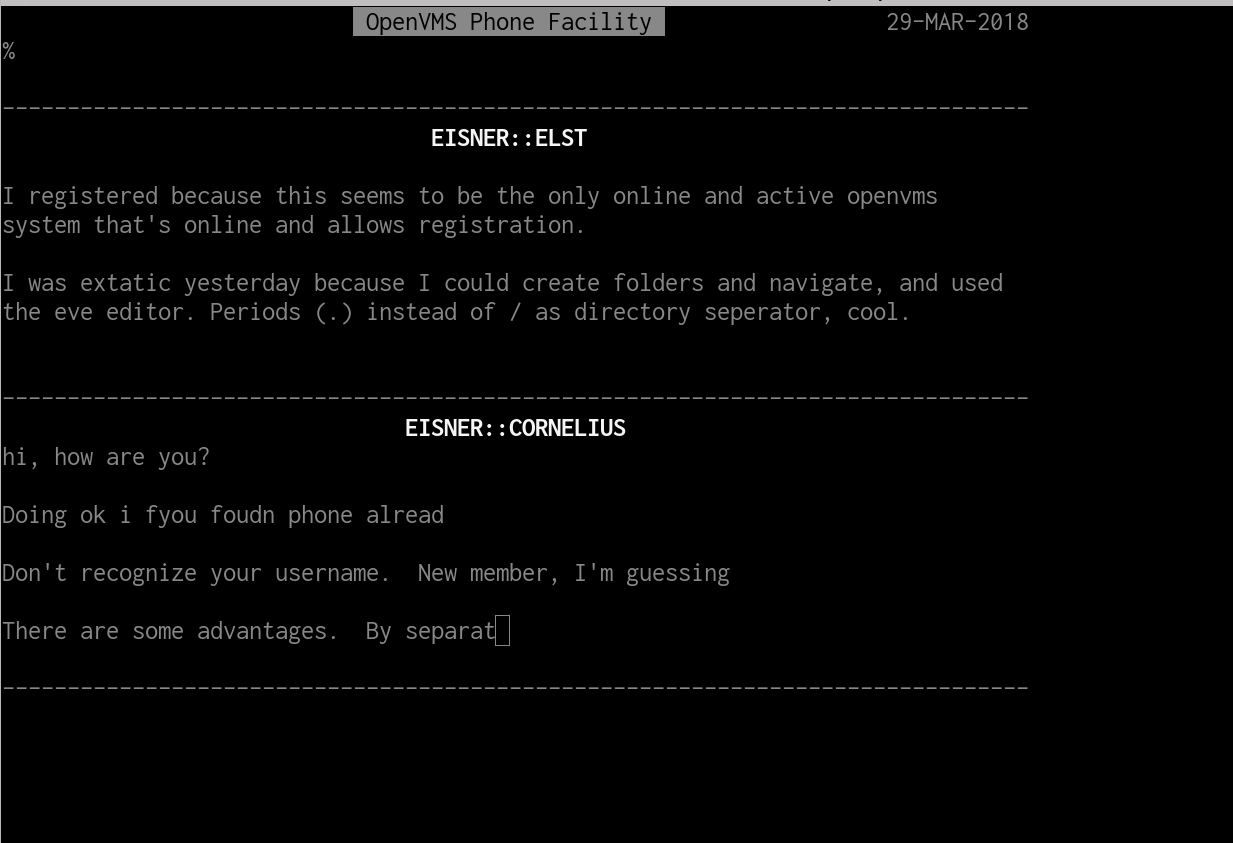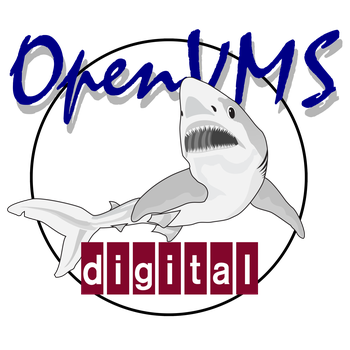Raymii.org

אֶשָּׂא עֵינַי אֶל־הֶהָרִים מֵאַיִן יָבֹא עֶזְרִֽי׃Home | About | All pages | Cluster Status | RSS Feed
My first OpenVMS
Published: 31-03-2018 | Author: Remy van Elst | Text only version of this article
❗ This post is over seven years old. It may no longer be up to date. Opinions may have changed.
Table of Contents
(You can read all my OpenVMS articles by clicking the picture above)
Last week I registered myself with the DECUServe OpenVMS system. I also registered with HP as an OpenVMS hobbyist and got OpenVMS 7.3 for VAX. This small blog item describes my first steps with the hosted DECUS OpenVMS system. I'm excited since I now know how to create folders, navigate the filesystem and edit files. Oh and I had a nice chat with another OpenVMS user via the PHONE program.
As I like to mess around with legacy systems like the PDP-8 and the PDP-11, VAX/VMS and thus OpenVMS seems to be a great step forward. Started out as a hardware project to be a a 32-bit virtual address extension for the PDP-11, the VAX saw it's birth at DEC around 1977. Accompanied with several operating systems, like DEC systems before, the VAX could run a lot of software including PDP-11 software. Also released around 1977 was VMS, one of the operating systems for the VAX-11/780. Renamed to VAX/VMS with the release of version 2 in 1980. Ported to the Alpha architecture and renamed OpenVMS with version 6 in 1992. In 2001 with version 8.2 it was ported to the Intel Itanium architecture and now also being ported to the x86 architecture, hopefully ready in 2019, a port by VMS Software Inc. (VSI). A venerable operating system with lots of history behind it and a great future ahead.
Lively among hobbyists (Dutch article), with recent articles on clustering and installing OpenVMS, I wanted to enjoy this as well, so I decided to register as a hobbyist with HP Enterprise's OpenVMS Hobbyist program. It is required to be part of a 'chapter' of OpenVMS Hobbyists, and DECUServe seems to be the only club left that allows registration and is open to all.
At first I did not fill in a number and chapter, but was contacted by HPe to register with DECUS before I could become a member. So I did, via http://decus.org.
DECUServe Online
Using the following SSH command you can connect to DECUS and register:
ssh -oHostKeyAlgorithms=+ssh-dss REGISTRATION@eisner.decus.org
Follow the online interactive instructions and you're good to go.
As I registered I can login with my username and password:
N O T I C E
This is Encompasserve. Access is for subscribed individuals only.
o By logging into the system you agree to abide by the Encompasserve
Canons of Conduct.
o Source code or any other information posted on this system is not
warranted in any way. YOU USE IT AT YOUR OWN RISK.
o If you submit source code to or post information on this system, you
must allow its unrestricted use. You must have the right to grant
such permission.
o Refer to the Encompasserve Canons of Conduct, posted in the
DECUServe_Information conference topic 4.3, for further guidance.
o Report problems in DECUServe_Forum.
For information about Encompasserve please login under -> Username INFORMATION
To subscribe to Encompasserve please login under -> Username REGISTRATION
To report any form of a problem please login under -> Username PROBLEMS
To renew an Expired account please login under -> Username REGISTRATION
EXAMPLE@eisner.decus.org's password:
Last interactive login on Thursday, 29-MAR-2018 03:22:35.36
1 login failure since last successful login
You have 1 new Mail message.
%DCL-S-SPAWNED, process EXAMPLE_45713 spawned
User [EXAMPLE] has 63 blocks used, 9937 available,
of 10000 authorized and permitted overdraft of 0 blocks on DISK_USER
$
Subprocess EXAMPLE_45713 has completed
Navigating the filesystem
Now for the most exiting part of my OpenVMS journey yet, navigating the
filesystem. It is not as you would expect on a Linux/UNIX system, as ls
dropped me into some sort of file editor:
$ ls
[End of File]
Buffer: $MAIN | Write | Insert | Forward
(Pressed CTRL+Z)
LSE> exit
$
Okay, that's not working. Lets try the (Windows) alternative:
$ DIR
Directory EISNER$DRA3:[DECUSERVE_USER.EXAMPLE]
$MAIN.TPU$JOURNAL;1 ICREATEDAFOLDERYAY.DIR;1 LOGIN.COM;1
MAIL.MAI;1 NOTES$NOTEBOOK.NOTE;1 REMY.DAT;2
REMY.DAT;1 WWW.DIR;1
Total of 8
To be honest, I found out that command after reading through 9 chapters of OpenVMS documentation from HP.
As you can see I managed to create some files and a folder. As you might also notice, the names and structure is way different that a Linux filesystem.
This is my understanding so far. OpenVMS directories are not seperated by a /
(as on UNIX) but a dot (.). A full file path can be addressed by it's file
specification that has the following format:
node::device:[root.][directory]file-name.file-type;version
So in the case above, there is an INDEX.HTML file in the WWW folder, which
can be addressed via:
$ dir [.WWW]
Directory EISNER$DRA3:[DECUSERVE_USER.EXAMPLE.WWW]
INDEX.HTML;1
Total of 1 file.
As far as I know a folder should be surrounded by [brackets] and the dot in
front of WWW specifies the current folder. I could also write the full file
specification:
$ dir EISNER$DRA3:[DECUSERVE_USER.EXAMPLE.WWW]
Directory EISNER$DRA3:[DECUSERVE_USER.EXAMPLE.WWW]
INDEX.HTML;1
Total of 1 file.
Creating a folder is not done with mkdir:
$ mkdir raymii
%DCL-W-IVVERB, unrecognized command verb - check validity and spelling
\MKDIR\
But with the logically named create command, and the correct folder
specifications, with brackets and a leading dot:
$ create /dir [.RAYMII]
$ dir [.RAYMII]
%DIRECT-W-NOFILES, no files found
Changing folders, again, not done with cd. Printing the current folder is not
pwd as well, but show default:
$ show default
DISK_USER:[DECUSERVE_USER.EXAMPLE]
Changing the folder is set default:
$ set default [.WWW]
$ dir
Directory EISNER$DRA3:[DECUSERVE_USER.EXAMPLE.WWW]
INDEX.HTML;1
Total of 1 file.
Changing back to the previous folder:
$ set default DISK_USER:[DECUSERVE_USER.EXAMPLE]
$ dir
Directory EISNER$DRA3:[DECUSERVE_USER.EXAMPLE]
$MAIN.TPU$JOURNAL;1 ICREATEDAFOLDERYAY.DIR;1 LOGIN.COM;1
MAIL.MAI;1 NOTES$NOTEBOOK.NOTE;1 REMY.DAT;2
REMY.DAT;1 WWW.DIR;1
Total of 8 files.
$
Editing text files
I very briefly dabbled with EVE to create some files:
EVE REMY.DAT
hello
print
this is a test
[End of file]
Buffer: REMY.DAT | Write | Insert | Forward
5 lines read from file EISNER$DRA3:[DECUSERVE_USER.EXAMPLE]REMY.DAT;2
It seems to be an interactive editor, pressing CTRL+Z saves the file:
7 lines written to file EISNER$DRA3:[DECUSERVE_USER.EXAMPLE]REMY.DAT;3
Other editors are available, like TECO, which was on several PDP-8 operating
systems as well. To be continued in a new article.
File versioning
As you saw in the above examples, OpenVMS by default supports file versioning. On every file on it's filesystem. How awesome is that? 32,767 versions are supported by default and there is nothing you have to do or remember. Just create and edit files!
Managing versions is quite easy as well. Since the version number is appended to
the filename (REMY.DAT;1) after a semicolon, you just use file system commands
(which I haven't figured out yet) to remove or edit specific versions.
Editing version 2 of the file REMY.DAT:
EVE REMY.DAT;2
Or using the TYPE command (cat on linux) to show the difference:
Version 2:
$ type REMY.DAT;2
hello
print
this is a test
Version 1:
$ type REMY.DAT;1
hello
this is a test
I don't understand we don't have this as an option on modern linux systems to
enable. Windows has something like it, VSS, but that has to be set up and
provides only timed backups. This however is default and awesome.
PHONE
Using the SHOW USERS command I was able to see a list of currently logged in
users:
$ show users
OpenVMS User Processes at 31-MAR-2018 14:46:06.54
Total number of users = 9, number of processes = 11
Username Interactive Subprocess Batch
EXAMPLE 1
HARROD 1
HENKLE 2 1
JACKSON 1
MALMBERG 1
PARRIS 1
REICHERT_D 1
SCHENKENBERG 1
SPALDING 1
There was a user online and I used the PHONE program to initiate a chat with
CORNELIUS (hi George). It was a nice chat, until work required attention. Exit
with CTRL+Z.
Thank you George for the nice talk we had!

The above image shows my discussion with George and my enthousiasm on just having figured out how to create a folder on this OpenVMS system.
Other commands
I found out, with the documentation, some other commands.
The show command shows general information:
$ show system
OpenVMS V8.4-2L2 on node EISNER 31-MAR-2018 14:32:46.22 Uptime 9 03:43:15
Pid Process Name State Pri I/O CPU Page flts Pages
00000201 SWAPPER HIB 16 0 0 00:00:04.75 0 4
00000204 LANACP HIB 14 69 0 00:00:00.03 112 138
00000206 FASTPATH_SERVER HIB 10 9 0 00:00:00.03 78 95
00000207 IPCACP HIB 10 10 0 00:00:00.00 37 51
00000208 ERRFMT HIB 8 13946 0 00:00:03.87 113 134
$ show network
Product: MULTINET Node: Eisner.Encompasserve.org Address(es): 10.10.127.2
Product: DECNET Node: EISNER Address(es): 11.91
$ show cpu
System: EISNER, AlphaServer DS20 500 MHz
CPU ownership sets:
Active 0,1
Configure 0,1
CPU state sets:
Potential 0,1
Autostart 0,1
Powered Down None
Not Present None
Hard Excluded None
Failover None
$ show memory
System Memory Resources on 31-MAR-2018 14:39:40.52
Physical Memory Usage (pages): Total Free In Use Modified
Main Memory (1.50GB) 196608 21718 163141 11749
Extended File Cache (Time of last reset: 22-MAR-2018 10:48:42.07)
Allocated (MBytes) 749.39 Maximum size (MBytes) 768.00
Free (MBytes) 0.04 Minimum size (MBytes) 3.12
In use (MBytes) 749.35 Percentage Read I/Os 92%
The HELP command is very good as well:
$ help show
SHOW
Displays information about the current status of a process, the
system, or devices in the system.
Format
SHOW option
Additional information available:
Description ACCOUNTING ACL AUDIT BROADCAST CLUSTER CPU DEFAULT DEVICES DISPLAY ENTRY
ERROR FASTPATH IMAGE INTRUSION KEY LICENSE LOGICAL MEMORY NETWORK PRINTER PROCESS
PROTECTION QUEUE QUOTA RMS_DEFAULT ROOT SECURITY SERVER SHADOW STATUS SYMBOL SYSTEM
TERMINAL TIME TRANSLATION USERS WORKING_SET ZONE
Conclusion
I'm very happy this system exists and that there are still other people around
to keep it running and let new folks like me enjoy and learn about it. The last
time I was so enthousiastic about navigating a file system was with the PDP-8
and OS/8, and now with OpenVMS. I do expect to learn more about OpenVMS and
eventually installing my own system with simh and the Hobbyist binaries I got
from HPe, including a ISO image for OpenVMS 7.3 for the VAX architecture.
I do have one unread email, but no idea how to read that. So that will be the next challenge ahead, figure out how to read and reply to emails. Fun times ahead!
Oh and I also don't know yet how to exit an SSH session other than closing the window.
Tags: alpha , blog , dec , decus , itanium , openvms , pdp , simh , vax , vms